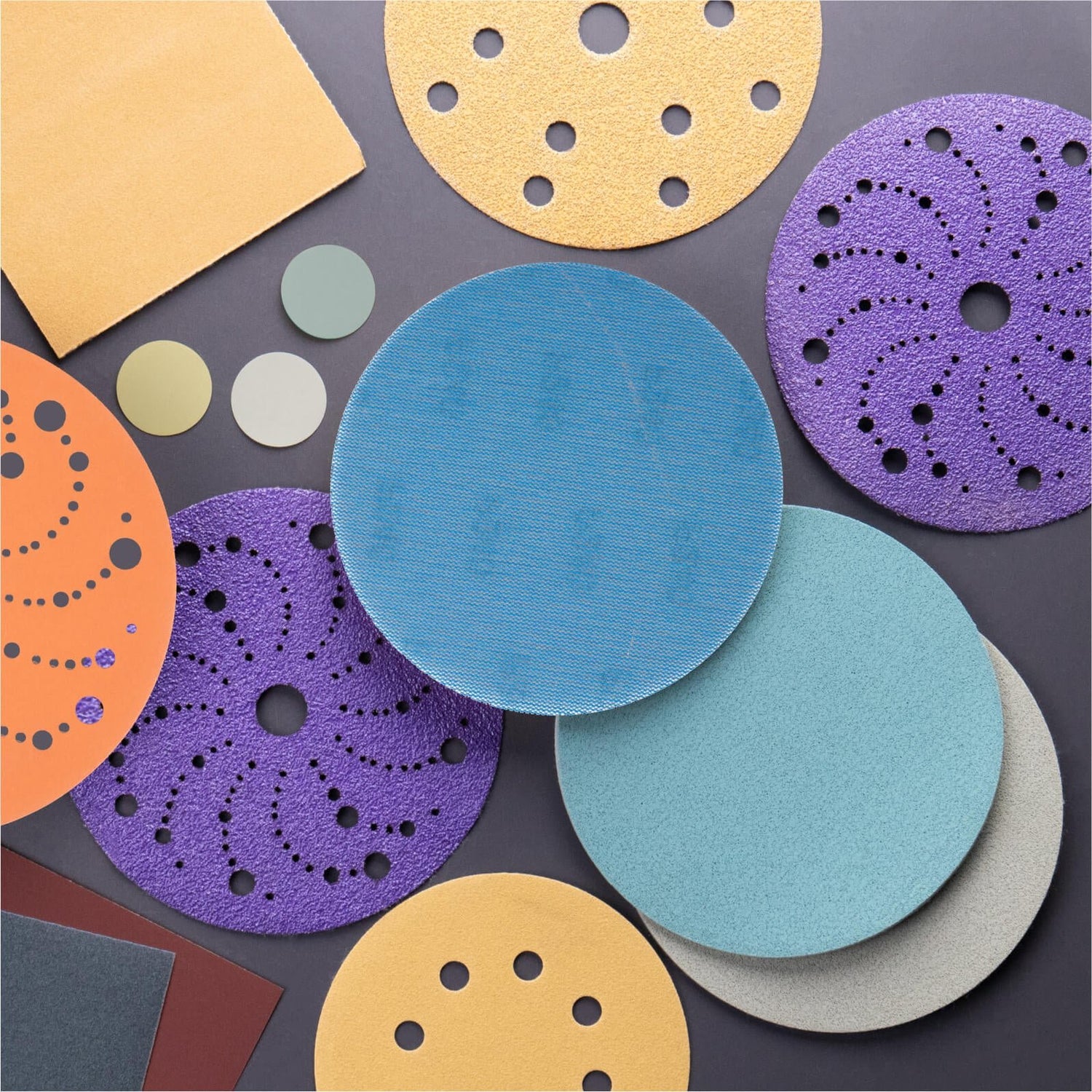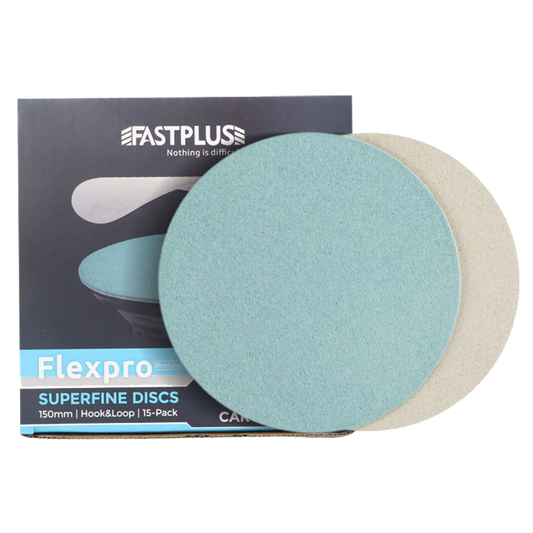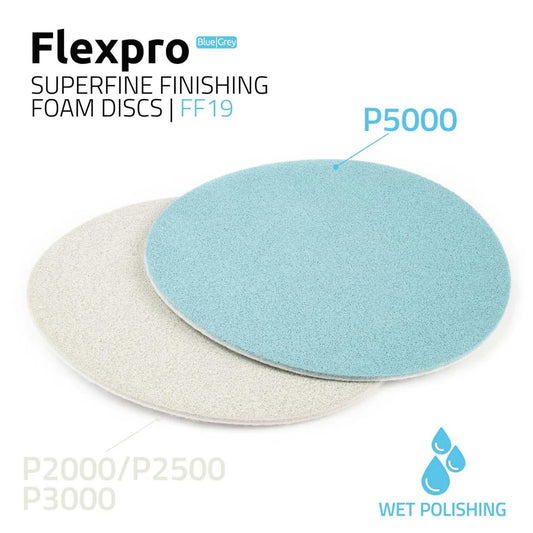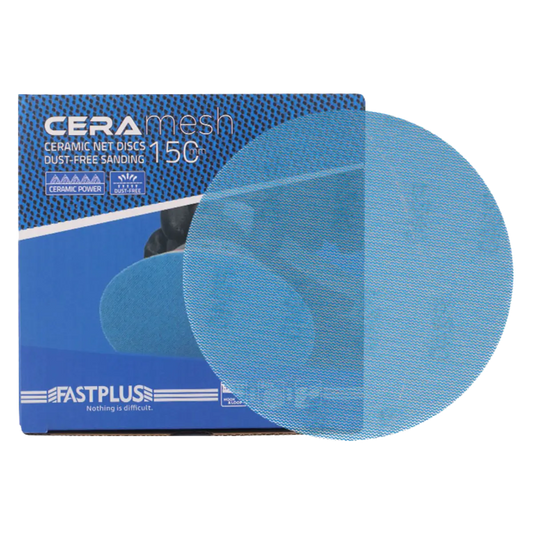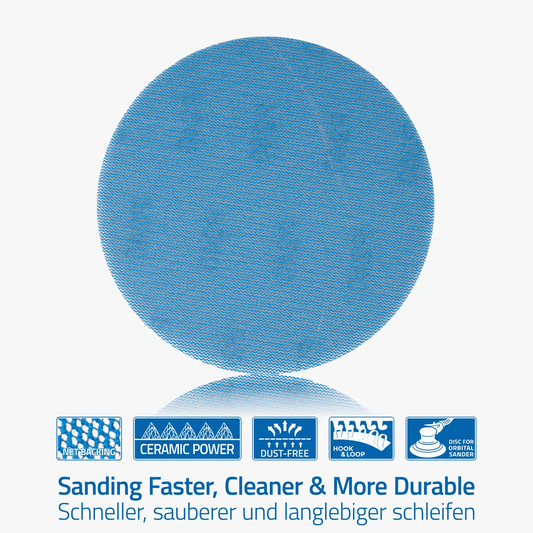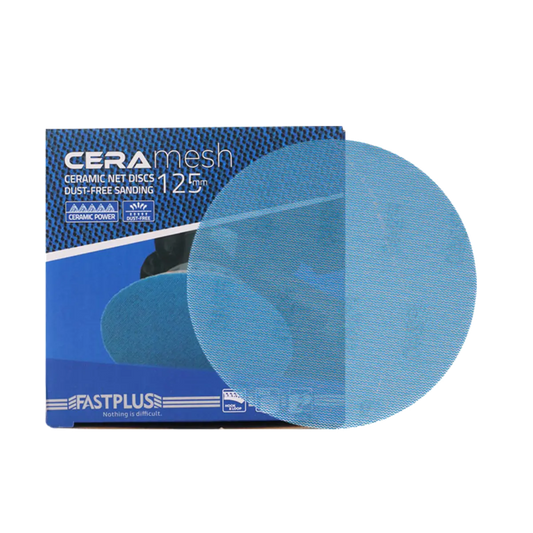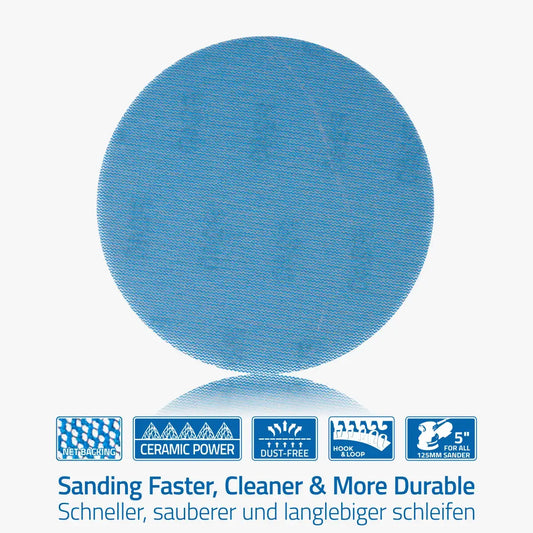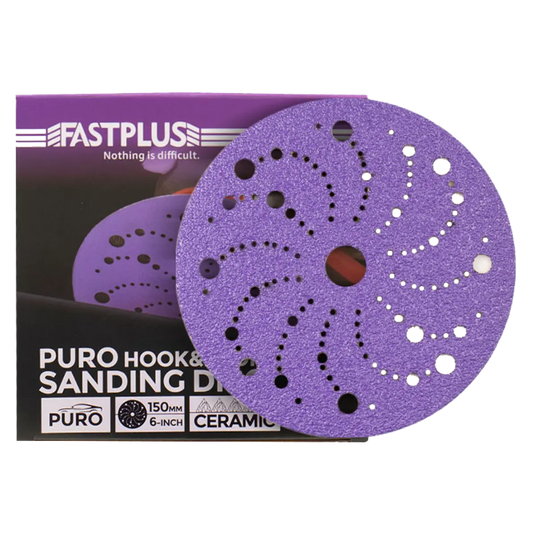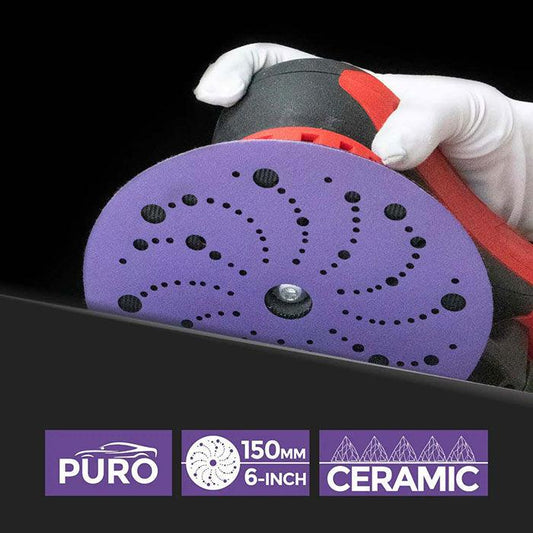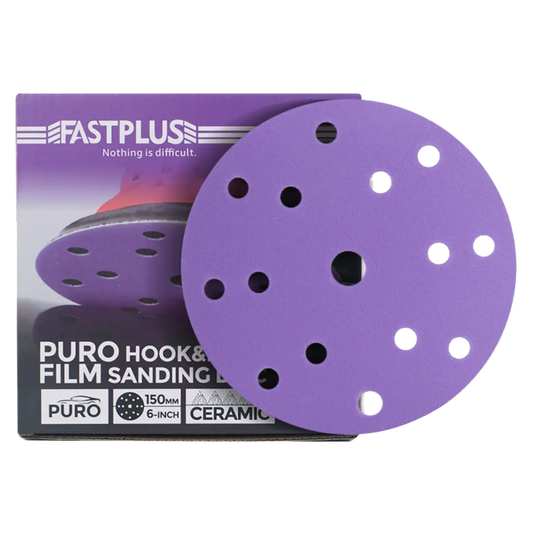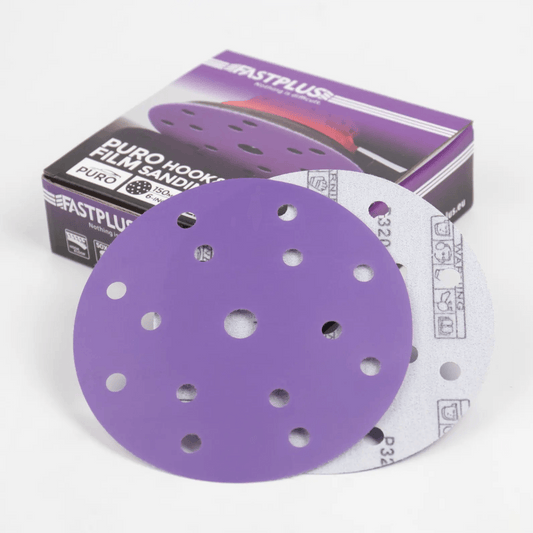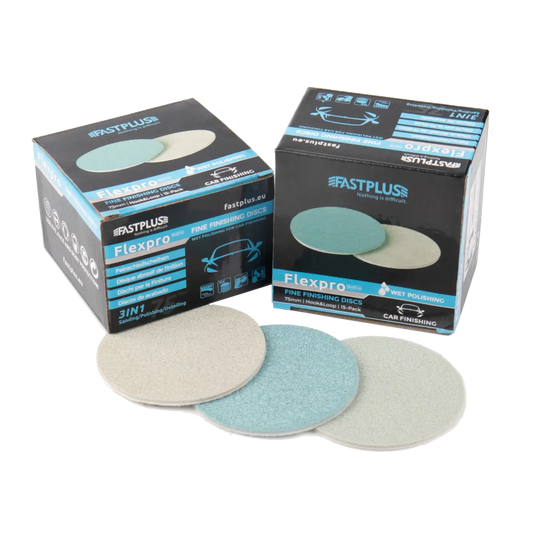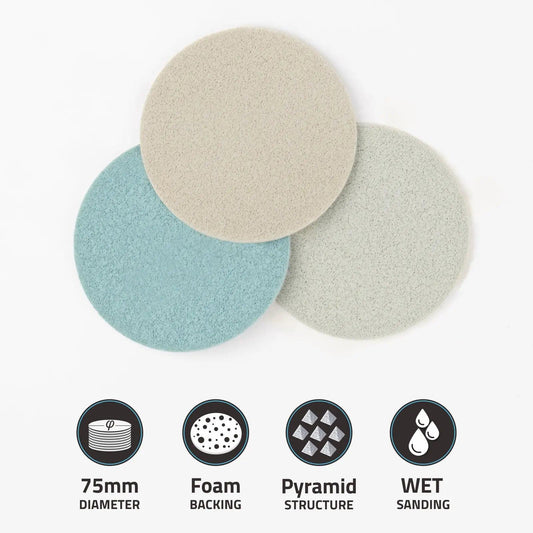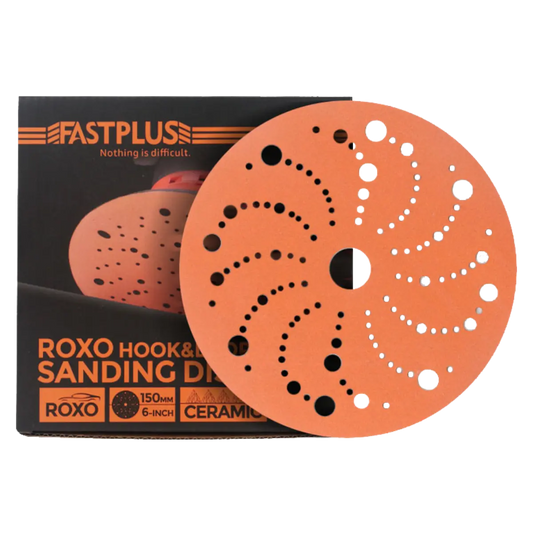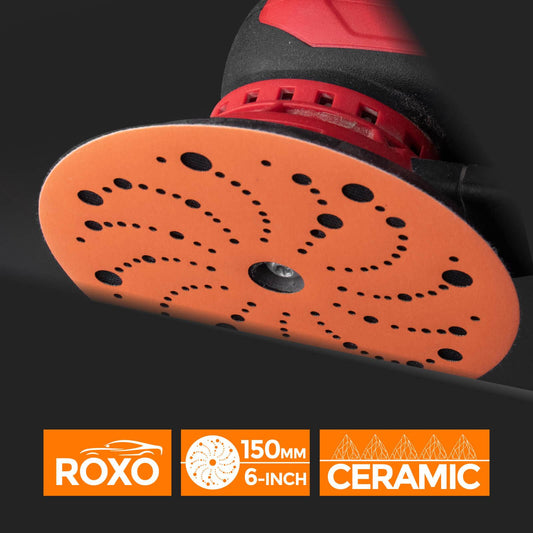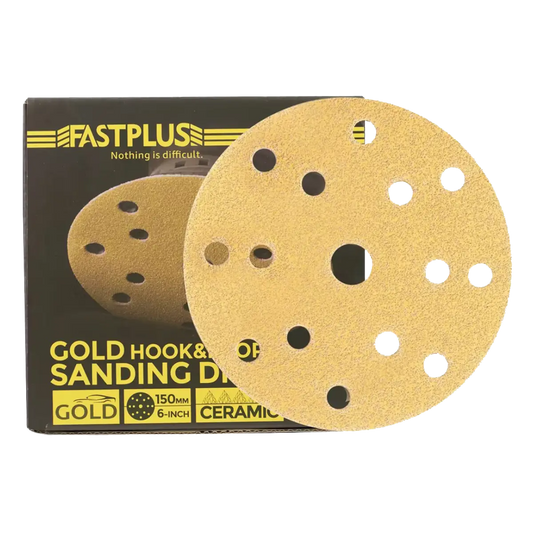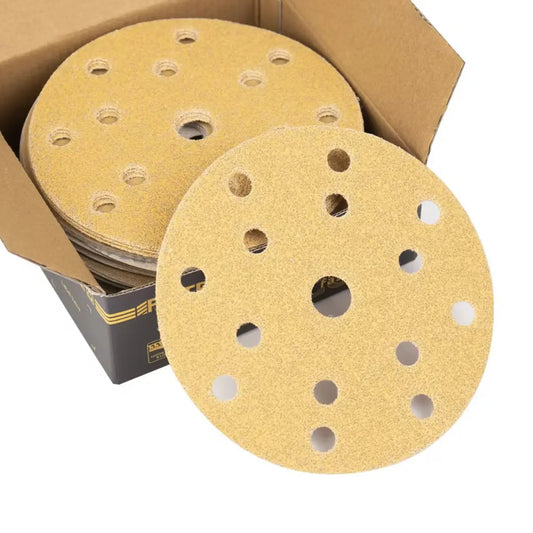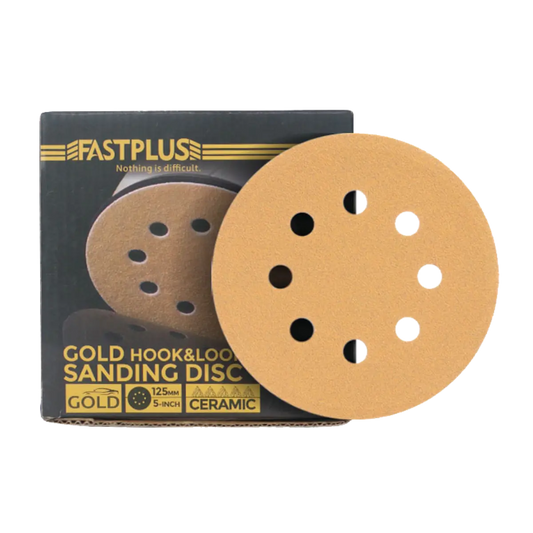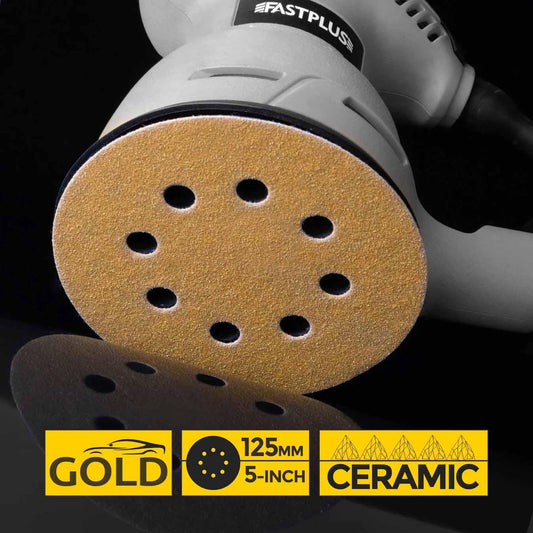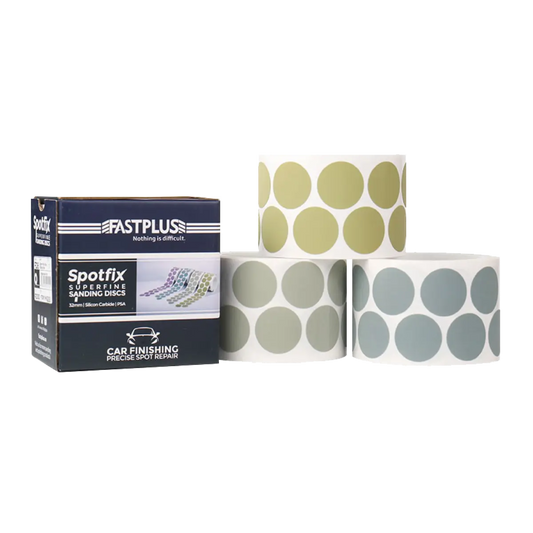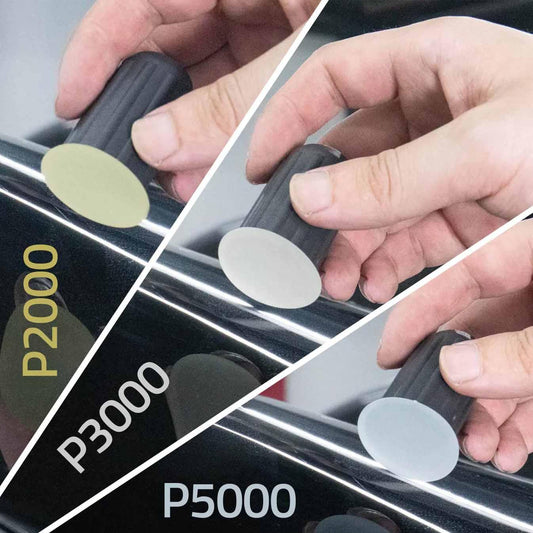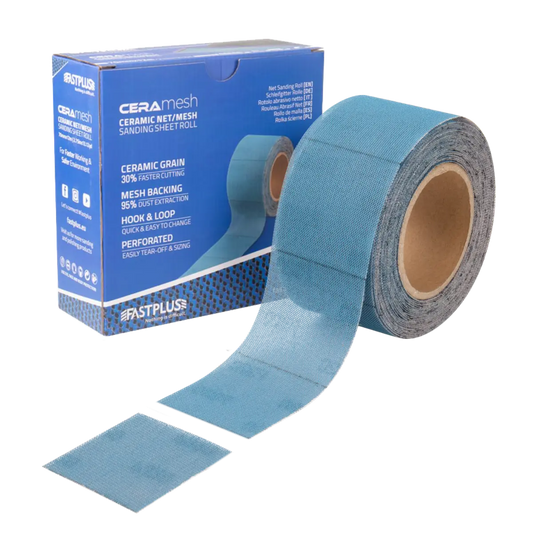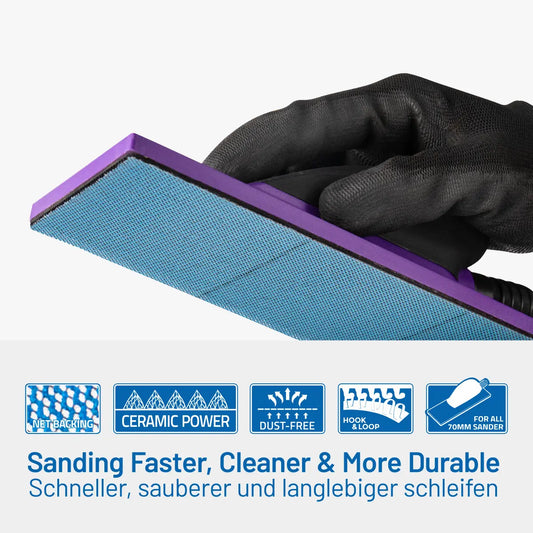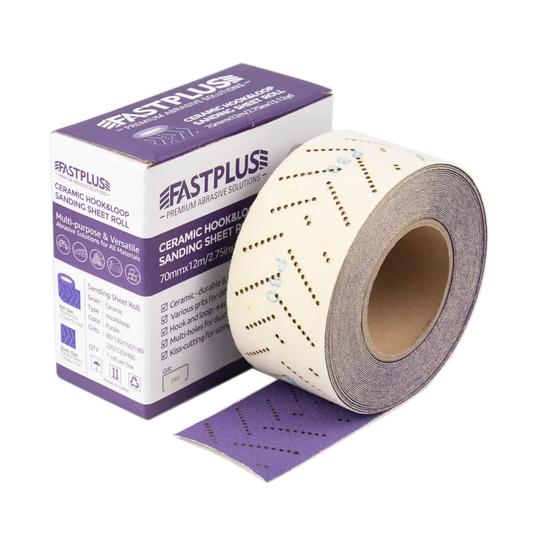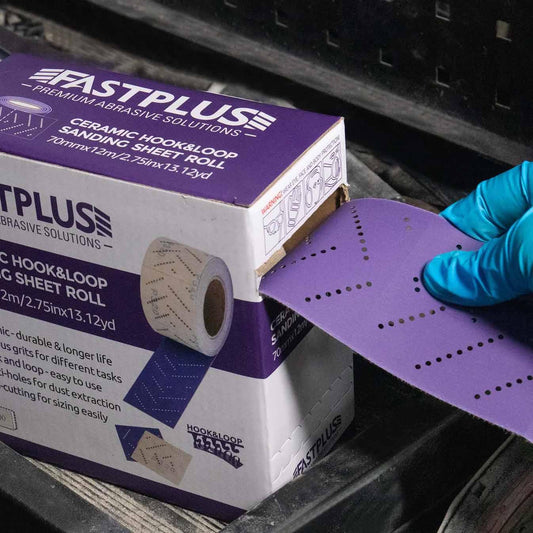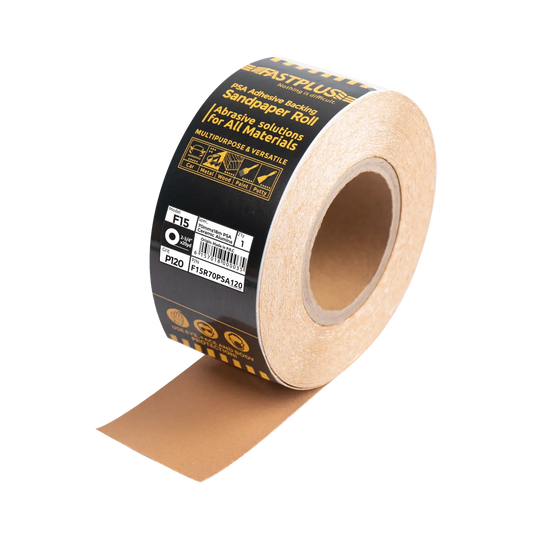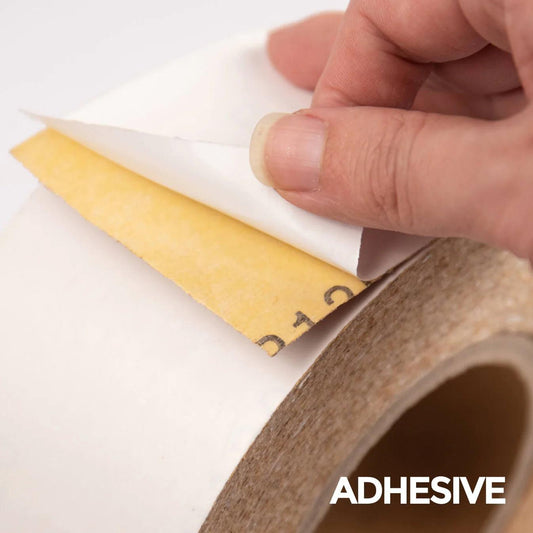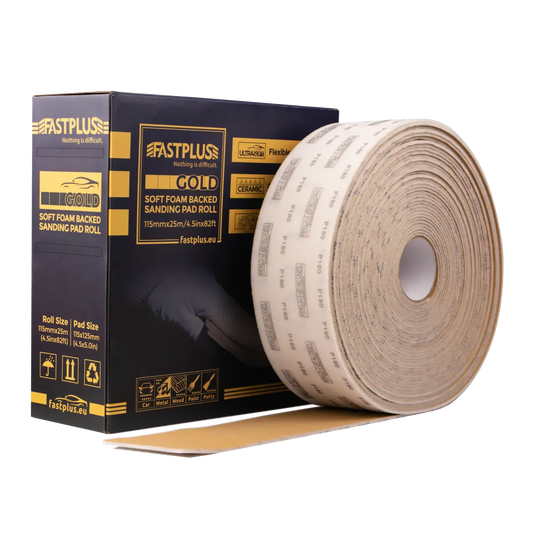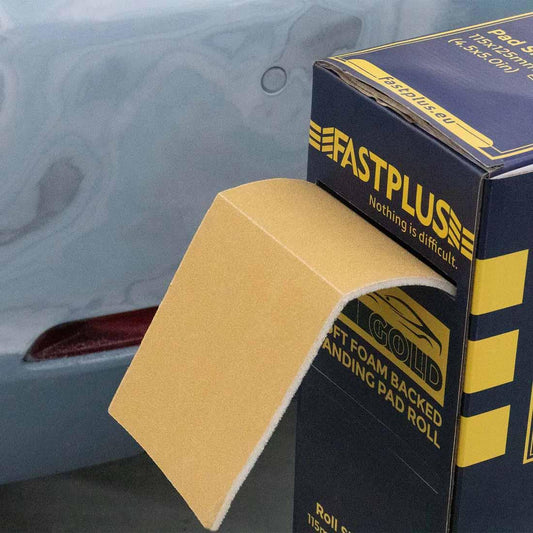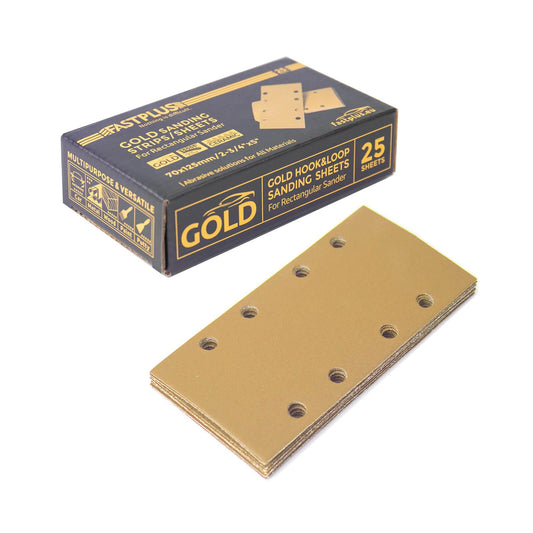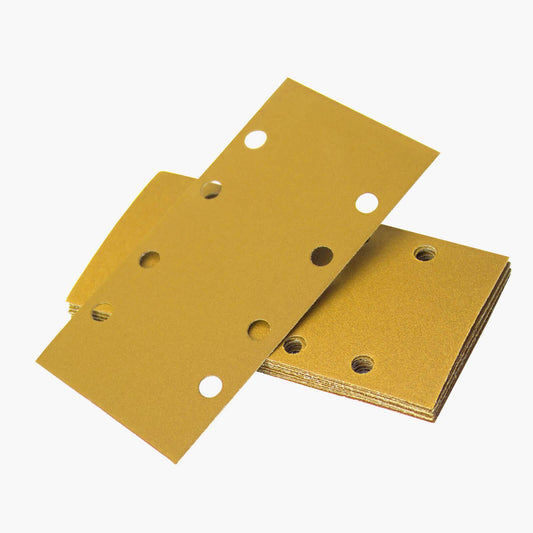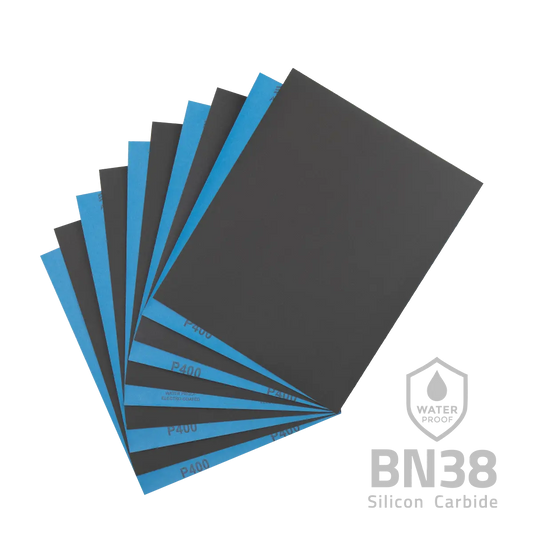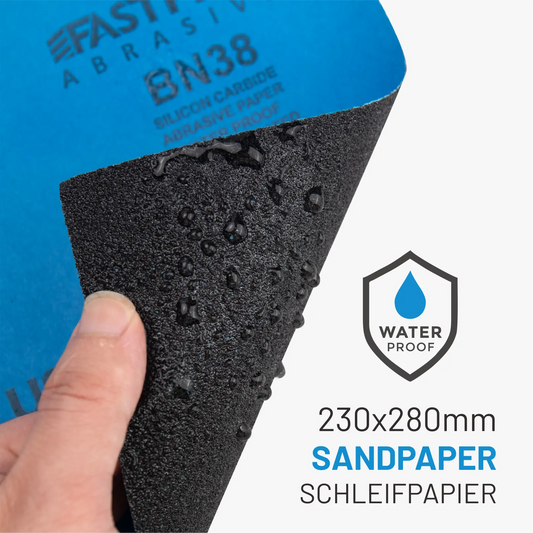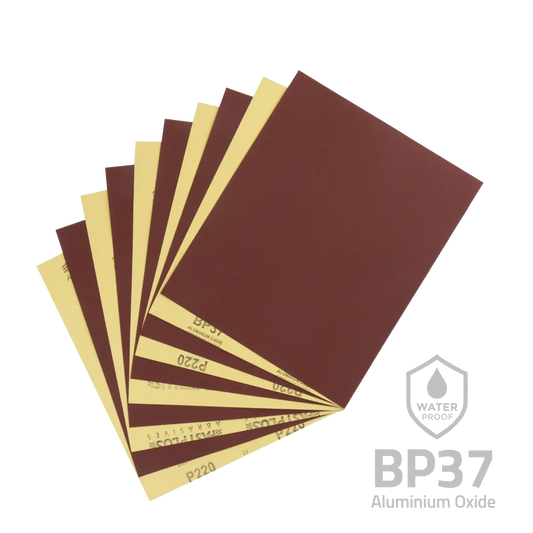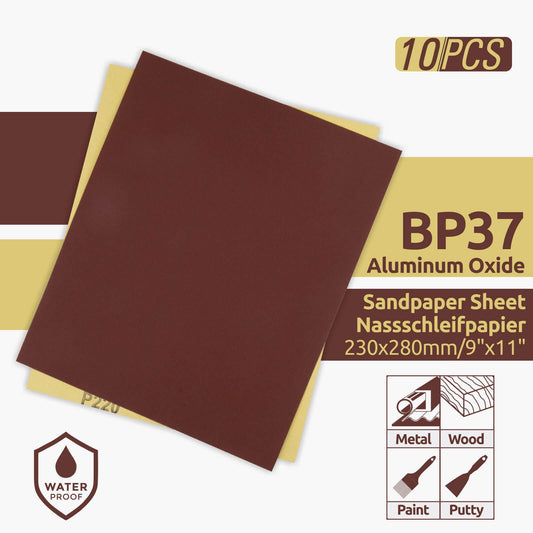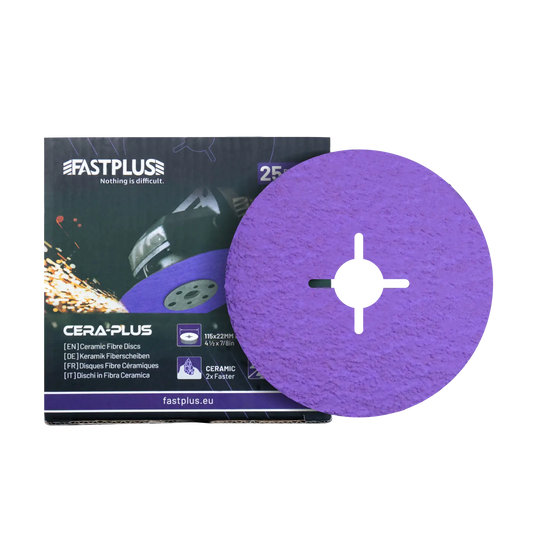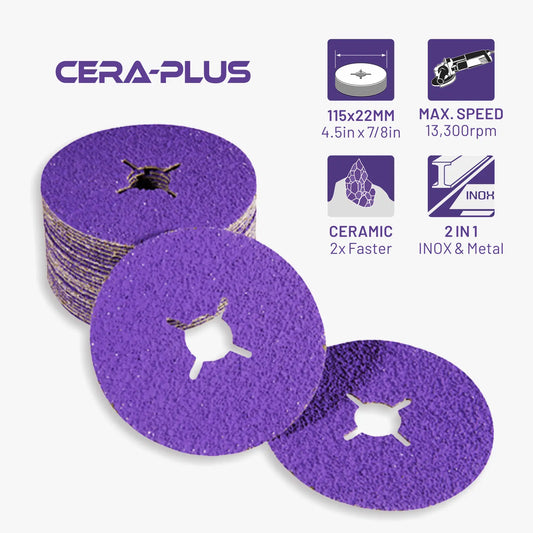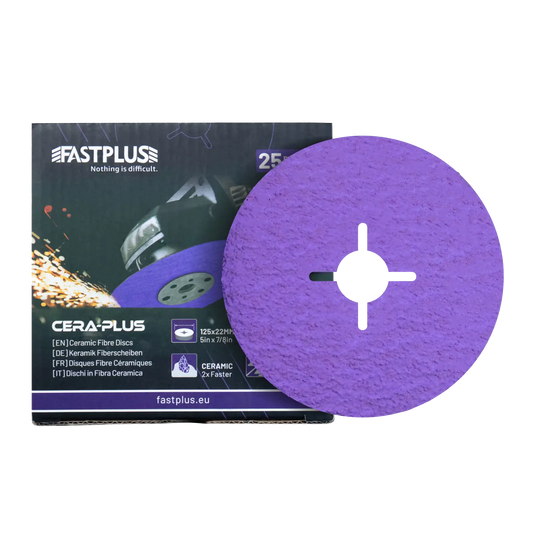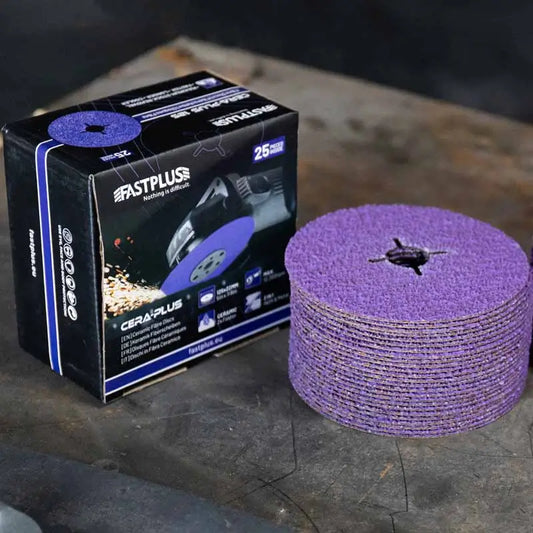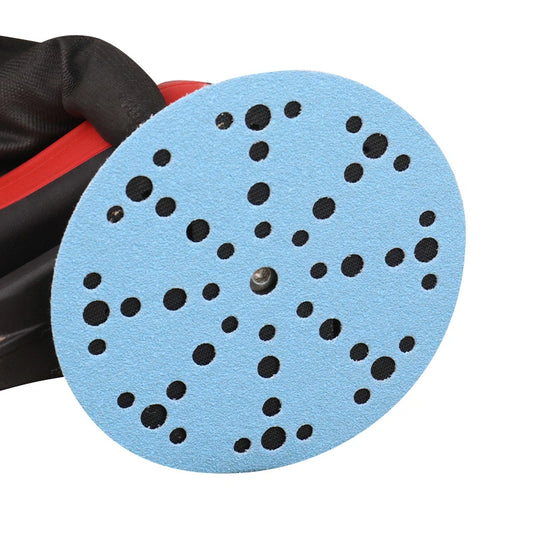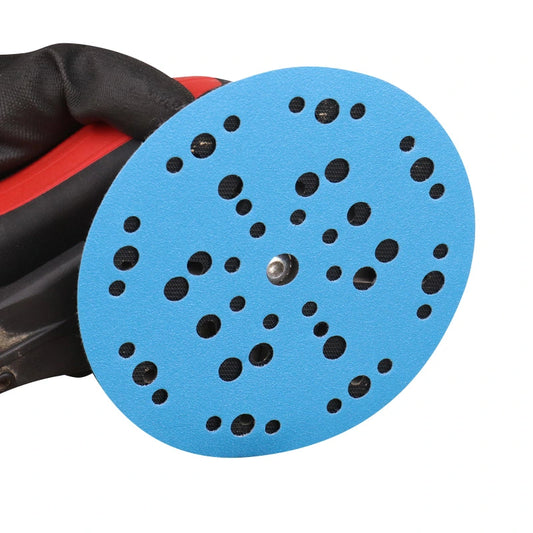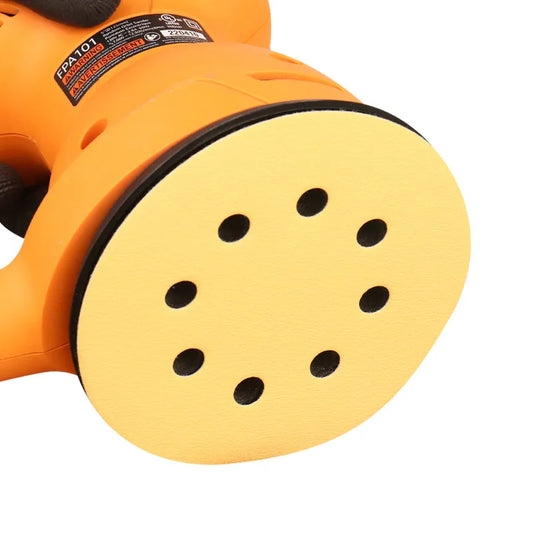
BUY SANDPAPERS FOR YOUR SANDING JOBS
FastPlus provides an extensive range of sandpapers for automotives, wood, metalworking from preparation to finish, including sanding discs, film abrasives, sanding mesh, fine finishing discs, sanding sheets, wet sandpaper with a wide variety of shapes, sizes, grits, and grades to ensure a perfect finish.
-
150mm Flexpro Fine Finishing Foam Discs FF19 Grip 15-piece
4.99 / 5.0
(72) 72 total reviews
Regular price From €38,59Regular priceUnit price / per -
Net Sanding Disc CeraMesh 150mm, Anti-clogging Dust-free Ceramic Mesh Discs Blue 50-pack
5.0 / 5.0
(48) 48 total reviews
Regular price €39,59Regular priceUnit price / per -
Net Sanding Disc 125mm CeraMesh Dust-free Ceramic + Mesh Discs Blue 50-piece
5.0 / 5.0
(23) 23 total reviews
Regular price €32,59Regular priceUnit price / per -
PURO Sanding Discs 150mm 119 Holes
5.0 / 5.0
(112) 112 total reviews
Regular price From €26,99Regular priceUnit price / per -
Film Sanding Disc PuroFilm 150mm Ceramic Velcro 15 Holes 50 pieces
4.98 / 5.0
(40) 40 total reviews
Regular price €32,59Regular priceUnit price / per -
75mm FlexPro Fine Finishing Foam Discs FF19 Velcro 15 pieces
5.0 / 5.0
(21) 21 total reviews
Regular price From €38,59Regular priceUnit price / per€35,59Sale price From €38,59 -
ROXO Sanding Discs Ceramic 150mm 119 Holes 50 pieces
4.97 / 5.0
(37) 37 total reviews
Regular price €26,99Regular priceUnit price / per -
GOLD Sanding Discs 150mm 15 Holes 50 pieces
4.99 / 5.0
(71) 71 total reviews
Regular price From €19,69Regular priceUnit price / per -
GOLD Sanding Discs Ceramic 125mm 8 Holes 50 pieces
5.0 / 5.0
(66) 66 total reviews
Regular price From €15,59Regular priceUnit price / per -
Spotfix Micro Film Discs, 32mm PSA Daisy Disc for Spot Repair and Smart Repair
5.0 / 5.0
(6) 6 total reviews
Regular price From €18,59Regular priceUnit price / per -
Net Sanding Roll CeraMesh Ceramic + Mesh Velcro Strips 70mm, 12m/Roll
5.0 / 5.0
(7) 7 total reviews
Regular price From €39,59Regular priceUnit price €3,55 / per m -
Sanding Sheet Roll PURO 70mmx12m Ceramic Velcro Multi-hole
5.0 / 5.0
(31) 31 total reviews
Regular price €29,59Regular priceUnit price / per -
PSA Sandpaper Roll, Sticky Backing 70mmx18m
5.0 / 5.0
(29) 29 total reviews
Regular price €20,59Regular priceUnit price / per -
Foam Sanding Pad Roll, Ultra-Soft Handpad Pre-cut 115mmx25m
5.0 / 5.0
(16) 16 total reviews
Regular price €34,59Regular priceUnit price / per -
GOLD Sanding Strips Velcro 70x125mm 8 Holes 25 Sheets
5.0 / 5.0
(3) 3 total reviews
Regular price €6,59Regular priceUnit price / per -
Wet and Dry Sandpaper, BN38 SiC 230x280mm 10 pieces
5.0 / 5.0
(42) 42 total reviews
Regular price From €5,00Regular priceUnit price / per -
Wet or Dry Sandpaper, BP37 230x280mm 10 pieces
5.0 / 5.0
(10) 10 total reviews
Regular price €5,00Regular priceUnit price / per€4,50Sale price €5,00 -
Fiber Discs 115mm Cera-Plus Ceramic + Resin Fiber 25 Pack
5.0 / 5.0
(8) 8 total reviews
Regular price From €31,59Regular priceUnit price / per -
Resin Fiber Discs 125mm Cera-Plus Ceramic + Resin Fiber 25 Pack
4.91 / 5.0
(11) 11 total reviews
Regular price From €33,59Regular priceUnit price / per -
Sanding Discs 150mm x 49 Hole Blue Ceramic for Festool Machine F65 – 50 Pack
Regular price €32,59Regular priceUnit price / per -
Sanding Discs 150mm x 47 Hole Blue Ceramic Adaptative F65 – 50 Pack
Regular price €32,59Regular priceUnit price / per -
Sanding Discs 225mm x Multi-Hole Blue Ceramic for Drywall & Floor Sanding F65 – 25 Pack
Regular price €38,59Regular priceUnit price / per -
Sanding Discs 225mm x 8+1 Hole Gold for Drywall & Floor Sanding F15 – 25 Pack
Regular price €35,99Regular priceUnit price / per -
Sanding Discs 125mm x 8 Hole Yellow Aluminium Oxide F25 – 50 Pack
Regular price From €15,59Regular priceUnit price / per
Sandpaper and Sanding
Looking for sandpaper to smooth out paint, varnish, primer, stain, or materials such as metal, plastic, galvanized steel, polyester, plastic, and wood? FastPlus is your one-stop shop for all types of sandpaper in any grit coarseness and size. Whether you need sandpaper for a sander, sanding block, sanding file, or hand sanding, FastPlus offers a variety of professional sandpaper including:
- Sanding discs
- Sanding mesh
- Film Sanding Discs
- Fine-finishing Discs
- Sandpaper rolls
- Sanding strips
- Waterproof Sandpaper Sheets
What is Sandpaper?
Sandpaper is a unique and durable paper that has abrasive grains of an abrasive material glued to it. It’s used for sanding to remove an old layer of paint, car paint, clearcoat, or to smooth a surface. This makes sandpaper a popular choice among painters, car damage repairers, handymen, and hobbyists. Sandpaper is also used to roughen a smooth surface to achieve adhesion for bonding, varnishing, or painting.
What is the Abrasive grade of Sandpaper?
The coarseness of sandpaper is indicated by the letter P followed by a number. The lower the P number, the coarser the grain on the sandpaper is. If you have a P number with a high number, then the sandpaper contains a fine grit. Coarse sandpaper is used to quickly remove old paint, rust, varnish, and stain by sanding. A commonly used coarse sanding grit is P80. For light sanding and matting the surface or material, a fine sanding grit starting at P600 and finer is recommended.
How to Choose The Right Grit Sandpaper?
Depending on your job, you may be wondering what grit sandpaper you need for the best result. Here’s a guide:
- Sandpaper grit 80 to 150: Ideal for removing paint, varnish, rust, and corrosion by sanding. If desired, you could sand even coarser with 60-grit paper.
- Sandpaper 150 to 240-grit paper: Perfect for sanding existing paint and varnish where the surface does not need to be completely stripped bare. Sand in steps from P150 to P240.
- Sandpaper grit 180 to 320: Suitable for sanding a primer or primer before applying a new coat of paint. Sand it lightly in steps from P180 to P320 for a nice smooth result.
- Sandpaper grit 400 to 800: Ideal for roughening up metal, plastic, aluminum, stainless steel, carbon, or other materials by light sanding. Then use sandpaper grit P400 to P800 in stages to prepare the surface for a new coat of paint, varnish, or stain.
- Sandpaper 1500 to 2500 grit: Perfect for repairing orange peel paint, also called orange peel. Sand in steps from grit P1500 to P2500, then polish the paint. With sandpaper P1500 and P2500 you can also repair sanding scratches by sanding the surface smooth.
- Abrasive paper grit 3000 to 5000: Ideal for wet sanding and polishing car paint. Then use special waterproof sandpaper P3000 and P5000. By wet sanding with water and grit 3000 or 5000, you get an incredibly smooth and matted paint after which you can polish it completely tight.
Sanding car with Sandpaper
Sanding a car with sandpaper removes paint, rust, or roughens up the existing paint. Sanding the car with sandpaper is done when you want to spray new paint. Sanding car paint makes the bodywork smooth again and achieves the best adhesion of the new paint.

Waterproof sandpaper
Waterproof sandpaper is used with water for wet sanding. This is why wet sanding with waterproof sandpaper is also called wet sanding. By sanding with water, the grain on the sandpaper breaks down very finely so that you get a nice and even scratch pattern. In addition, wet sanding with water ensures that the waterproof sandpaper does not create dust so that the result and the surroundings stay clean.
Mesh/Net Sanding Discs
Sanding mesh is the best material for sanding without dust. This special sanding mesh is also called a sanding net because the ceramic sanding grains are sprinkled on an open-net construction. As a result, with a sanding net, you have dust extraction over the entire surface of the material. The sanding mesh is best used on your sander using a protective pad to protect the backing pad from wear. At FastPlus, you can buy sanding mesh by grit in 50-piece packs.

Professional Sandpaper from FastPlus
Professional sandpaper from FastPlus is used daily for sanding wood, metal, plastic, fiberglass, aluminum, stainless steel, plastic, carbon, and more. In collaboration with professionals and demanding users, FastPlus’s sandpaper is developed to meet all your user requirements. This professional sandpaper from FastPlus is sprinkled with a high-quality ceramic grit known for its high cutting capacity and long service life.
Ordering Sandpaper at FastPlus Online Store
Ordering sandpaper from Fastplus is done by grain in both small and large packs with an extra discount on quantity orders. At fastplus.eu you can order all types of sandpapers as eccentric sanding discs, hand sanding pads, sanding mesh, block sanding paper, fine-finishing discs and more.
-
150mm Flexpro Fine Finishing Foam Discs FF19 Grip 15-piece
Regular price From €38,59Regular priceUnit price / per -
Net Sanding Disc CeraMesh 150mm, Anti-clogging Dust-free Ceramic Mesh Discs Blue 50-pack
Regular price €39,59Regular priceUnit price / per -
Net Sanding Disc 125mm CeraMesh Dust-free Ceramic + Mesh Discs Blue 50-piece
Regular price €32,59Regular priceUnit price / per -
PURO Sanding Discs 150mm 119 Holes
Regular price From €26,99Regular priceUnit price / per -
Film Sanding Disc PuroFilm 150mm Ceramic Velcro 15 Holes 50 pieces
Regular price €32,59Regular priceUnit price / per -
75mm FlexPro Fine Finishing Foam Discs FF19 Velcro 15 pieces
Regular price From €38,59Regular priceUnit price / per€35,59Sale price From €38,59

FASTPLUS ABRASIVES
Abrasive Sanding Products
Abrasive Sanding Discs
What is A Sanding Disc?
The sanding disc is a circular abrasive disc that is attached to power sanders or other tools to remove material, light defects, corrosion, paint, and rust from wood, metal, and plastic surfaces. The hook and loop sanding discs and PSA abrasive discs are commonly used and come with different grits, holes, coated grains, backings, and colors. Fastplus is constantly adding more sanding discs into product lines, below is a short buying guide of our sanding discs to help buy the right one for your work.
What are the Types of Sanding Discs?
The sanding discs can be divided into 2 types from the mounting features: One is the hook and loop (velcro) sanding discs, and the other is quick change and PSA/adhesive-backed abrasive discs.
Hook & Loop Sanding Discs: Backed with hook and loop (velcro) system, which allows sanding discs can be attached firmly and removed quickly for better efficiency.
Standard sizes: 125mm, 150mm / 5”, 6”
Holes/ Perforation: No hole, 6/8/9/15/17/multi-holes
Abrasive types: Aluminum oxide, Zirconia alumina, Ceramic
Coating Types: Open coat, semi-open coat, closed coat
Compatible tools: Random orbital sanders, disc sanders or handheld rotary tools.
Common uses: Sanding wood, fiberglass, metal, paint and plastic surfaces
PSA Sanding Discs: Backed with Pressure Sensitive Adhesive (PSA), this kind of self-adhesive abrasive disc can be mounted to the sanding tools easily and quickly. PSA discs are generally made with cloth or paper backing, cloth backed sanding discs are used for heavy-duty sanding, and paper-backed PSA discs are featured as more affordable and lightweight and used for light sanding tasks.
Standard sizes: 125mm, 150mm / 5”, 6”
Holes/ Perforation: No hole
Abrasive Types: Aluminum oxide, Zirconia alumina, Ceramic
Coating Types: semi-open coat, closed coat
Compatible tools: Random orbital sanders, disc sanders, bench sanders, platen disc sanders
Common uses: Grinding, Sanding and finishing of wood, fiberglass, metal, paint and plastic surfaces
Other types of discs: Film Sanding Discs, net/mesh abrasive discs, scuff discs and superfine sanding discs
How to Select the Right Size of Sandpaper Grit?
Distinguishing sandpaper grit sizes is important because not every project requires the same.
In the United States, grit is determined based on a gradation scale established by the Coated Abrasive Manufacturers Institute (CAMI). When shopping for sandpaper, you’ll see numbers such as 80-grit, 100-grit, or 200-grit. Keep in mind:
The higher the number, the smaller the grains and the finer the sandpaper grit.
And, conversely, lower numbers indicate larger grains and overall coarser sandpaper.
On the CAMI scale, sandpaper grit is measured in microns, and to get an idea of how small a micron is, check out a piece of 100-grit sandpaper. The small grains on the sandpaper measure approximately 141 microns in size, which is equivalent to .00550 of an inch. Very small.
Most sandpaper you buy at DIY centers and lumberyards will bear the CAMI scale, but if you order sandpaper online, you may run across sandpaper grit sized by the Federation of European Producers of Abrasives (FEPA). Grit sized with the FEPA scale is indicated by the letter “P” preceding the grit number. While there are too many grit gradations to list, if you’re buying FEPA-sized sandpaper, the following commonly used CAMI sizes will give you an idea of the corresponding FEPA sizes. FEPA sizes are not an identical match to CAMI sizes, but you can get something very close by selecting one of the two closest FEPA numbers.
40-grit (CAMI) sandpaper corresponds closely to (FEPA) P-36 or P-40
80-grit (CAMI) sandpaper corresponds closely to (FEPA) P-80 or F-100
100-grit (CAMI) sandpaper corresponds closely to (FEPA) P-100 or P-120
120-grit (CAMI) sandpaper corresponds closely to (FEPA) P-120 or P-150
220-grit (CAMI) sandpaper corresponds closely to (FEPA) P-180 or P-220
400-grit (CAMI) sandpaper corresponds closely to (FEPA) P-600 or P-800
Generally, the following can be a guide to select the right grit size of sanding discs or sandpapers:
P40 For removing thick layers of rust and lacquer.
P60 For pre-treating unprocessed surfaces.
P80 For correcting heavy areas of unevenness.
P120 For roughening before priming or pickling.
P180 For initial sanding after priming.
P240 For initial wet sanding after priming.
P400 For smoothing filled surfaces.
P600 For fine sanding before painting.
P1000 For final fine sanding before painting.
P1200 For final fine sanding before painting.
P2000 For final fine sanding before painting.
Sanding Strips / Sheets
Different than conventional aluminium oxide or silicon carbide sanding sheets, Fastplus™ F15 Gold sanding strips or sanding sheets are made of premium ceramic alumina grain which is cutting faster, lasts longer, and is relatively cost-effective.
F15 Gold sanding strips are specially stearate coated to deliver high anti-clogging which are greatly optimized the sanding performances. Fastplus™ Gold sanding sheets come with 70x125mm and 8 perforated holes which are perfectly fit all standard eccentric sanders and hand sanding blocks with dust collection and manual sanding tools and suitable for high-speed sanding in multi-purpose applications.
The 70x125mm Gold sanding strips are used for sanding on materials: Body fillers, paint, lacquers, metal, ferrous metal, non-ferrous metal, stainless steel, composite, wood, granite, marble, glass, plastic, and PVC.
Film Abrasives
What is Film Abrasive Disc?
Film abrasives feature film backing construction (in contrast to conventional paper), finer mineral grains and anti-clogging stearate coating to provide better flexibility, crease & tear resistance and consistent surface finish than conventional abrasives.
The Applications of Film Abrasive Discs
Film abrasive is excellent for finishing primers, composite materials, wood, wood coatings, scratch-resistant clear coats, blend preparation of clears, removal of orange peel, denibbing paint and much more. Mist the surface with water for best performance.
How to Select Right Grit Size of Film Sanding Disc?
Generally, the following can be a guide to select the right grit size:
P80 For correcting heavy areas of unevenness.
P120 For roughening before priming or pickling.
P180 For initial sanding after priming.
P240 For initial wet sanding after priming.
P400 For smoothing filled surfaces.
P600 For fine sanding before painting.
P1000 For final fine sanding before painting.
P1200 For final fine sanding before painting.
P2000 For final fine sanding before painting.
Buy Fastplus Film Sanding Discs for your project.
Sanding Sheet Rolls
The sanding sheet rolls are sandpapers that be made into sheet rolls, the roll can be torn into sheets along the kiss-cutting line. The abrasive sheet rolls can be perforated for the purpose of dust extraction for clogging resistance. The abrasive sheets are hook-and-loop or PSA backed for attached to pads or sanders easily which can be used with power tools and handheld sanders. The sanding sheet rolls are perfectly used in sanding on metal, paint, wood, and other applications.
Main Features:
• Durable and Long Lasting
• Hook-and-loop - easy to use
• Multi-holes for dust extraction
• Kiss-cutting for sizing easily
• Anti-clogging
• Various grits for different tasks
Materials can be used on:
• Metals
• Non-ferrous Metal
• Aluminum
• Stainless steel
• Steel
• Paint
• Plastic
• Wood
Tasks can be used for:
• Blending
• Light deburring
• Cleaning
• Removing rust
• Sanding lacquered wood
• Scuffing
• Paint removal
• Final preparation
Other Fastplus Sanding Rolls:
• PSA Sandpaper Roll
• Foam Sanding Pad Roll
Wet and Dry Sandpaper
What is Sandpaper?
Sandpaper is a type of coated abrasive that consists of sheets of paper or cloth with abrasive material glued to one face.
There are many varieties of sandpapers, with variations in the paper or backing, the material used for the grit, grit size, and the bond.
The Different Types of Sandpaper for Different Tasks
Buy the sandpaper that’s best for your project. Sandpaper comes in different materials. Each material works best with particular types of sanding.
Garnet - Commonly used in woodworking.
Emery - Commonly used to abrade or polish metals.
Aluminium oxide - The most common in modern use, with the widest variety of grits, the lowest unit cost; can be used on metal (i.e. body shops) or wood.
Silicon carbide - Available in very coarse grits all the way through to microgrits, common in wet applications.
Alumina-zirconia - (An aluminium oxide–zirconium oxide alloy), is used for machine grinding applications.
Chromium(III) oxide - Used in extremely fine micron grit (micrometer level) papers.
Diamond: Used for finishing and polishing hard metals, ceramics, and glass.
Ceramic alumina - Used in high-pressure applications, used in both coated abrasives, as well as in bonded abrasives.
Wet and Dry Sandpaper
Abrasive papers and cloths with a waterproof backing allow the use of a lubricant, typically water, which can both decapitate rough surfaces when used dry and produce a semi-polished satin-type finish when wet. Super-fine grades can produce a "key" adhesion surface appropriate for spray painting in critical decorative applications such as automotive bodywork repair
Aluminium oxide sandpaper 230x280mm
Silicon carbide sandpaper 230x280mm
How to Select the Right Grit Size of Sandpaper?
Sandpaper is graded based on the number of abrasive particles per square inch that make up the sandpaper. The higher the number, the smaller the grains and the finer the sandpaper grit.
And, conversely, lower numbers indicate larger grains and overall coarser sandpaper.
P60-220 grit: for rough sanding and removing scratches
P320-400 grit: for light sanding between coats of finish or to sand metal and other hard surfaces.
P400-800 grit: for final finishing before painting.
P1000-1500 grit: for sanding between coats
P2000-3000 grit: for buffing.
Learn more detals about sandpapers
Scuff Abrasives
Scuff abrasives are made with premium Non-Woven synthetic webbing and coated with silicon Carbide or Aluminum Oxide abrasive grains. The scuff abrasives are usually made into scuff pads, scuff rolls and scuff discs. The scuff abrasives can be cut easily and used as alternatives to steel wool, or other non-woven abrasives. They are anti-clogging and waterproof which can be used with water and wet condition. The scuff abrasives are widely used to remove rust, clean, finish and polish metal and hard surfaces.
Main Features:
• Durable and Long Lasting
• Easily Cut
• Anti-clogging
• Waterproof: Washable and reusable
• Various coarseness for different tasks
Materials can be used on:
• Metals
• Non-ferrous Metal
• Aluminum
• Stainless steel
• Steel
• Paint
• Plastic
• Wood
Tasks can be used for:
• Blending
• Light deburring
• Cleaning
• Removing rust
• Sanding lacquered wood
• Scuffing
• Paint removal
• Final preparation
Sanding Sponge
Sanding sponges are made from a flexible sponge that’s covered with sanding grit, the suppleness of a sanding sponge allows the user to sand rounded edges uniformly just by pressing the sponge on the edge while sanding. Some sanding sponges come with a beveled side that helps with sanding in tight spots, such as around the base of stair balusters.
These sanding sponges are the everyday sanding tool. Similar to regular sandpaper, sanding sponges come in various grits.
Sanding sponges are just like regular sandpaper; the lower the number, the rougher the grit, and the more material the sanding sponge will remove. Likewise, higher grits will give you a smoother finish but remove less material.
There are also various sizes of sanding sponges. Some are large and fill up your whole hand. Larger sponges are useful for smoothing out drywall or preparing furniture for paint.
Smaller sanding sponges work well for detail work. Maybe you like to make small wooden crafts, and you need to keep your sanding precise – this is the time to go small.
How to Use a Sanding Sponge
Here are some guidelines to remember when using a sanding sponge.
Safety – always wear eye protection. It’s also a good idea to wear a face mask.
Start with a low grit – the lower the grit, the rougher the sandpaper, and the more material it will remove. Start with 80-grit or even 40-grit (for especially rough surfaces) and systematically work your way up. For most surfaces, you’ll want to work up to around 220 grit.
Sand with the grain – avoid sanding across the grain. Sanding with the grain gives you the smoothest finish and avoids scratch marks.
Mark the area you’d like to sand – when using a sanding sponge, you’re going to remove material quickly. You don’t want to sand off a corner you needed accidentally.
Use even pressure – let the sandpaper do the work. A comfortable pressure is all you need – this will prevent avoidable scratches. If you feel like you’re not removing enough material, try using a lower grit before you tire yourself out.
